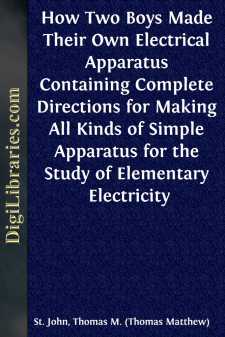Categories
- Antiques & Collectibles 13
- Architecture 36
- Art 48
- Bibles 22
- Biography & Autobiography 813
- Body, Mind & Spirit 142
- Business & Economics 28
- Children's Books 17
- Children's Fiction 14
- Computers 4
- Cooking 94
- Crafts & Hobbies 4
- Drama 346
- Education 46
- Family & Relationships 57
- Fiction 11829
- Games 19
- Gardening 17
- Health & Fitness 34
- History 1377
- House & Home 1
- Humor 147
- Juvenile Fiction 1873
- Juvenile Nonfiction 202
- Language Arts & Disciplines 88
- Law 16
- Literary Collections 686
- Literary Criticism 179
- Mathematics 13
- Medical 41
- Music 40
- Nature 179
- Non-Classifiable 1768
- Performing Arts 7
- Periodicals 1453
- Philosophy 64
- Photography 2
- Poetry 896
- Political Science 203
- Psychology 42
- Reference 154
- Religion 513
- Science 126
- Self-Help 84
- Social Science 81
- Sports & Recreation 34
- Study Aids 3
- Technology & Engineering 59
- Transportation 23
- Travel 463
- True Crime 29
How Two Boys Made Their Own Electrical Apparatus Containing Complete Directions for Making All Kinds of Simple Apparatus for the Study of Elementary Electricity
Categories:
Description:
Excerpt
APPARATUS 1.
1. Carbon-Zinc Cell. Fig. 1. If you have some rubber bands you can quickly make a cell out of rods of zinc and carbon. The rods are kept apart by putting a band, B, around each end of both rods. The bare wires are pinched under the upper bands. The whole is then bound together by means of the bands, A, and placed in a tumbler of fluid, as given in . This method does not make first-class connections between the wire and rods. ()
Fig. 1.APPARATUS 2.
Fig. 2.2. Carbon-Zinc Cell. Fig. 2. In case you want to make your cell out of carbon and zinc rods, and do not have any means of making holes for them in the wood, as in and , you will find this method useful. Cut grooves, G, into one side of the wood, A, which should be about 4½ × 1 × ½ in. The grooves should be quite deep, and so placed that the rods will be about ¼ in. apart. A strip of tin, T, ½ in. wide, should be bent around each rod. The screw, S, put through the two thicknesses of tin will hold the rod in place. Another screw, X, acts as a binding-post. The zinc rod only is shown in Fig. 2. The carbon rod is arranged in the same way. Use the fluid of .
3. Note. When the bichromate solution of is used for cells, the strong current is given, among other reasons, because the zinc is rapidly eaten up. This action goes on even when the circuit is broken, so always remove and wash the zinc as soon as you have finished.
APPARATUS 3.
4. Carbon-Zinc Cell. Fig. 3. The wooden cross-piece, A, is 4½ × 1 × ½ in. The carbon and zinc rods, C and Z, are 4 in. long × ½ in. in diameter. The holes are bored, if you have a brace and bit, so that they are ¾ in. apart, center to center. This makes the rods ¼ in. apart. To make connections between the rods and outside wires, cut a shallow slot at the front side of each hole, so that you can put a narrow strip of tin or copper, B, in the hole by the side of each rod. Setscrews, S, screwed in the side of A, will hold the rods in place, and at the same time press the strips, B, against them. Connections can easily be made between wire and B by using a spring binding-post, D, or by fastening the wire direct to the strips, as shown in .
Fig. 3.Use the battery fluid given in , and use a tumbler for the battery jar. This cell will run small, well-made motors, induction coils, etc. (.)
APPARATUS 4.
5. Carbon-Zinc Cell. Fig. 4. The general construction of this cell is the same as that of . There are 2 carbons, C, each 4 × ½ in. The holes for these are bored in A 1¼ in. apart, center to center. The zinc rod, Z, is a regular battery zinc, 6 × Ã¢â¦Å in., and has a binding-post, Y, of its own. The rods, C, are held in A, and connections are made as explained in .
Fig. 4.The wire, X, is fastened direct to the strips, B, as shown. When ready to use this cell, be sure that the wire connecting the carbons does not touch Z. (Why?) The other wire is connected to Y. The wooden piece is 4½ × 1 × ½ in. Use the battery fluid of in a tumbler. This cell will run small motors, and is good for induction coils, etc. (.)
APPARATUS 5.
Fig. 5.6. Experimental Cell. Fig. 5. Cut a strip each of copper, C, and zinc, Z. (See list of materials.) They should be about 2 in. wide and 4 in. long. Punch a hole through each, one side of the center, for screws, E....












